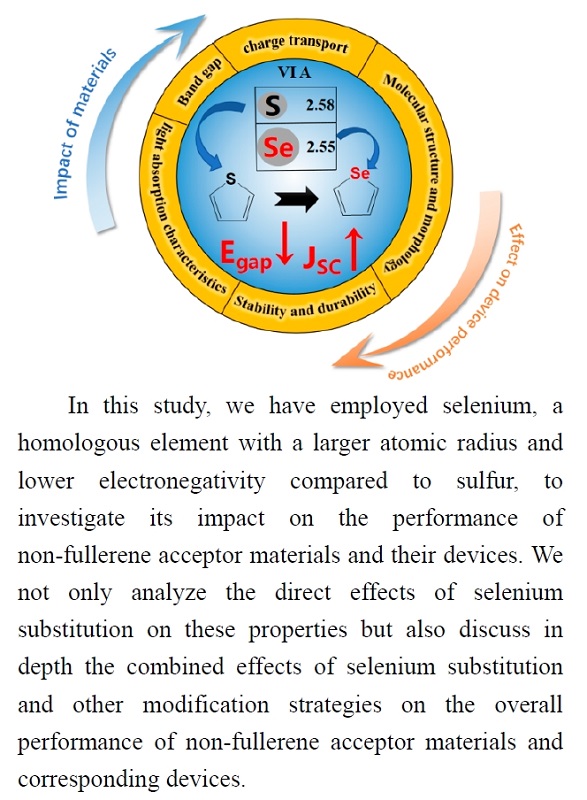 PDF(6567 KB)
PDF(6567 KB)


Non-Fullerene Acceptor Materials: Selenophenes Engineering
Huan Liu, Huimin Shi, Haiyang Li, Chuanlang Zhan
Prog Chem ›› 2025, Vol. 37 ›› Issue (2) : 235-254.
 PDF(6567 KB)
PDF(6567 KB)
 PDF(6567 KB)
PDF(6567 KB)
Non-Fullerene Acceptor Materials: Selenophenes Engineering
To advance the development of high-performance organic solar cells, in recent years, the academic community has conducted in-depth research on the design of non-fullerene acceptor materials and the interplay between their structure and properties. Structural modifications of these materials involve optimization of the core structure, side chain engineering, expansion of the conjugated system, and doping with heteroatoms. Focusing on sulfur, due to its outstanding semiconducting properties, it is widely used in the manufacturing of electronic materials and semiconductor devices, especially in the field of organic solar cells. Selenium, as a homologous element of sulfur, not only shares similar chemical and physical properties but also possesses unique characteristics. For instance, compared to sulfur, selenium has a larger atomic radius, which provides additional space within molecules, facilitating charge transfer and improving electron distribution. Moreover, due to its greater mass, selenium atoms have lower vibrational frequencies, a characteristic that enhances light absorption capabilities within the visible spectrum. Therefore, the introduction of selenium atoms is considered a potential approach to enhancing the efficiency of organic solar cells. This review focuses on the impact of the position and ratio of selenium atoms in condensed-ring electron acceptors (such as ITIC and Y6 derivatives) and certain non-condensed ring acceptors on their photovoltaic performance. It also discusses the synergistic effect of selenium atom substitution with other optimization strategies and its comprehensive impact on the performance of various types of organic solar cells (including small molecule, polymer, and all-polymer solar cells).
1 Introduction
2 Research on the Regulation of Photovoltaic Performance by Selenophenes for Non-Fullerene Electron Acceptors with Condensed Rings
2.1 Research on the regulation of photovoltaic performance by selenophenes for ITIC series acceptor materials
2.2 Research on the regulation of photovoltaic performance by selenophenes for Y series acceptor materials
2.3 Research on the regulation of photovoltaic performance by selenophenes for Y series polymer materials
2.4 Research on the regulation of photovoltaic performance by selenophenes for other types of acceptor materials
3 Research on the Regulation of photovoltaic Performance by Selenophenes for Non-Condensed Ring Non-Fullerene Electron Acceptors
4 Conclusion and outlook

organic solar cells / selenophenes / narrow bandgap / broad absorption
| [1] |
|
| [2] |
|
| [3] |
|
| [4] |
|
| [5] |
|
| [6] |
|
| [7] |
|
| [8] |
徐翔, 李坤, 魏擎亚, 袁俊, 邹应萍. 化学进展, 2021, 33(2): 165.
(
|
| [9] |
|
| [10] |
|
| [11] |
|
| [12] |
|
| [13] |
|
| [14] |
|
| [15] |
|
| [16] |
|
| [17] |
|
| [18] |
|
| [19] |
|
| [20] |
|
| [21] |
|
| [22] |
|
| [23] |
|
| [24] |
|
| [25] |
|
| [26] |
|
| [27] |
|
| [28] |
|
| [29] |
|
| [30] |
|
| [31] |
|
| [32] |
|
| [33] |
|
| [34] |
|
| [35] |
|
| [36] |
|
| [37] |
|
| [38] |
|
| [39] |
|
| [40] |
|
| [41] |
|
| [42] |
|
| [43] |
|
| [44] |
|
| [45] |
|
| [46] |
|
| [47] |
|
| [48] |
|
| [49] |
|
| [50] |
|
| [51] |
|
| [52] |
|
| [53] |
|
| [54] |
|
| [55] |
|
| [56] |
|
| [57] |
|
| [58] |
|
| [59] |
|
| [60] |
|
| [61] |
|
| [62] |
|
| [63] |
|
| [64] |
|
| [65] |
|
| [66] |
|
| [67] |
|
| [68] |
|
| [69] |
|
| [70] |
|
| [71] |
|
| [72] |
|
| [73] |
|
| [74] |
(薛朝鲁门, 刘宛茹, 白图雅, 韩明梅, 莎仁, 詹传郎. 化学进展, 2022, 34(2): 447.)
|
| [75] |
|
| [76] |
|
| [77] |
|
| [78] |
|
| [79] |
|
/
| 〈 |
|
〉 |